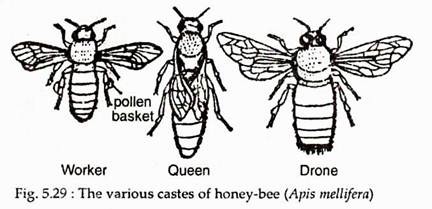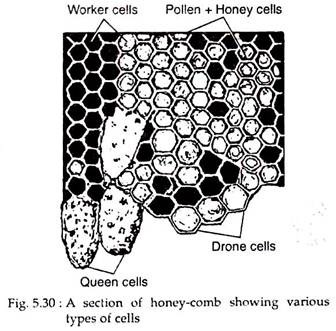In this article we will discuss about the social behaviour of honeybees.
Honeybees have developed one of the most highly organised societies. They live in colonies. The colonies of the honeybees are perennial and a good colony of honeybee may consist of 50,000 to 80,000 individuals. It comprises of one fertile female or the queen, a few hundreds of male bees or drones and the rest are sterile females or workers.
The queen lays the eggs which develops into new workers, drones and queens. She also emits a complex series of chemical secretions, the pheromones that regulate much of the behaviour of the workers. Both queen and worker are genetically diploid. Queens, however, are fed a special rich larval food; a white, foamy, yogurt-like royal jelly.
It is necessary for normal queen size and sexual development. Workers too, can develop into sexually reproducing females, but their reproductive organs are kept undeveloped through the effect of the queen’s pheromones. Drones are genetically haploid and are produced by the laying of unfertilized eggs by parthenogenesis. Drones are generally produced at the same time as the new queen.
A. Worker:
ADVERTISEMENTS:
The worker honeybee (Fig. 5.29) is the smallest member of the colony. It is black or brown in colour and its mouth parts are of the rasping and lapping type, to facilitate the collection of nectar and pollen. The legs are covered with hair and are adapted for gathering pollen.
The mesothoracic legs bear a pollen brush and a spine-like pollen spur to remove pollen from pollen baskets. The metathoracic legs has a depression called the pollen basket. The last four visible segments of the abdomen have modified cells on the ventral surface that secretes wax, which is essential for making the hive.
A worker honeybee lives for about 6 weeks as an adult and her activities are to some extent synchronized with her physiology. She spends the first three days in cleaning the cells and then begins feeding the older larvae a mixture of pollen and honey.
ADVERTISEMENTS:
This she picks up from the storage cells of the hive. The workers then start secreting the so-called royal jelly, and from about the 6th to the 14th day of her life she feeds this secretion to the younger larvae and any queen larvae in the hive.
For a brief period, the royal jelly is fed to all larvae, but those that will become the queen are fed with royal jelly throughout their larval period. Form the 10th day onwards, the worker’s wax-secreting glands on the abdomen become active and, at the same time, the pharyngeal glands begin to regress. The workers then gradually change their behaviour from feeding larvae to cell construction.
About the 18th day, the worker may leave the colony occasionally for a few brief orientation flights. At this stage, she may be found guarding the hive entrance and inspecting incoming bees. From the 21st day onwards the workers change into a forager, bringing back nectar, pollen and water, and continue this function for the rest part of its life.
B. Drone:
Drones are intermediate in size (Fig. 5.29) but considerably stouter and broader. They possess large eyes, small pointed mandibles and lack wax-producing glands, pollen-collecting apparatus and a sting. The drones do not do any work and, if not fed by the workers, they die. They exist only to mate with the queen.
C. Queen:
ADVERTISEMENTS:
The queen being the only fertile female of the hive, have immensely developed ovaries. The queen is elongated with a long tapering abdomen with comparatively shorter wings and legs. She has pointed mandibles and shorter mouth parts and sting with no barbs.
She alone lays eggs and is the mother of almost all the members of the hive. She lives for several successive years laying about 1-200 eggs a day and laying about 15 lakh eggs during her life time. When a hive of honeybees prepare to swarm or when an old queen becomes weak, the regulating pheromones of the queen also become weak. This serves as a signal for workers to begin raising a new queen.
Swarming:
Swarming takes place during the spring or early summer. This relieves over-crowding and also provides a means of founding new colonies. Prior to a swarm, a large number of queen and drone cells are constructed. Then on a clear day the old queen leaves the hive with a group of old workers and drones.
Left behind in the hive are the young workers and several new queens who are still in their cells but approaching the time of emergence. The first queen that hatches out becomes the mistress of the parent colony. This new queen kills any other newly-hatched rivals.
After about a week of her emergence, the queen flies off to mate. By this time, drones also have left the hive and have aggregated in traditional sites in large flying clouds. The drones from many neighbouring hives may also combine in such a cloud called drone cloud. When the new queen approaches such a drone cloud, the drones rush to the queen and several of them may mate with a queen in succession.
Mating occurs in mid-air. The sperms are stored in a spermatheca or sperm-reservoir of the queen, which fertilizes her eggs as long as she lives. The male dies after mating, with its genital parts remaining in the abdomen of the queen. It is later removed by the queen or by workers. The queen, after mating, returns back to the hive not to leave it again, until she grows old and leads a prime swarm.
ADVERTISEMENTS:
Bee-hive:
The bee-hive consists of two layers of hexagonal chambers or cells made by the bees wax secreted from the abdomen of the worker bees. Before the wax is used it is masticated and mixed with secretions of cephalic glands to convert it into a plastic substance.
The bee-hive consists of two types of cells:
1. Storage cells which contains honey and pollen, usually built near the top.
2. Brood cells generally occupy the lower and central portions.
They are of three types (Fig. 5.30) and differ in shape and size:
(i) Worker cells are small like the honey cells.
(ii) Drone cells are slightly larger.
(iii) Queen cells are enoromous, cylindrical or vase-shaped in structure. Once used these cells cannot be used again.
A bee-hive has elaborate homeostatic mechanisms that maintain a constant temperature, water balance and nutrient level. When the bee-hive is hot, worker bees fan air throughout it and cool it off. When the hive is short of water, then the nurse workers turn to the nearest workers and signal a need for water. The latter then gives what water it has and then turns to its neighbours.
Thus, the message of the shortage of water moves from bee to bee until it reaches a worker who leaves the hive and returns with more water. When a predator or parasite enters the hive, worker bees rush forward and defend the colony and in the process they may die. Thus, a bee-hive works as a marvelous society.

